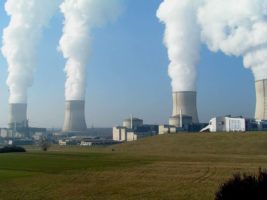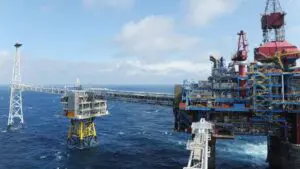It was nearly a year ago now when Australia’s biggest electricity producer, and its biggest coal generation company AGL Energy was marking the closure of the ageing and increasingly decrepit Liddell coal fired power station in the Hunter Valley.
At the time, a couple of leading Coalition politicians, including Nationals leader David Littleproud and energy spokesman Ted O’Brien were standing in front of cameras saying that generators like Liddell – even though they had become basically non-functional – should not be closed down. At least not until nuclear was available.
AGL’s senior executives were hosting media at the Liddell site at the time, so the question had to be posed: Would AGL consider going nuclear? CEO Damien Nicks almost choked on his bottle of water. “No,” he said emphatically. “Do I need to say anything else?”
Well, as it turns out, yes, he does. Nicks said at the time that the world is changing, but not – it seems – the Coalition.
The LNP nuclear fantasy has not gone away, and it’s now a core part of its energy and climate policy, which basically calls for the halt of the rollout of large-scale renewables, and as a result emission reductions, until such time as nuclear can be built.
The Coalition has not said where it would build these nuclear plants, although it promises to do so soon. It’s a fair bet that the Hunter Valley site where AGL has closed Liddell and still runs Bayswater would be a top priority, given its pivotal position in the NSW state transmission network.
AGL, though, is not having a bar of it, and in an extraordinary statement released late Friday, and covered briefly in our story of that day about the CSIRO fighting back against the Coalition’s attack on it – AGL made it clear it is not interested in nuclear.
“There is no viable schedule for the regulation or development of nuclear energy in Australia, and the cost, build time and public opinion are all prohibitive,” Nicks said in a statement, evidently prompted by its frustration at the debate.
Nicks made clear that AGL is turning its coal and gas power station sites into low emissions industry energy hubs, centred around `12 GW of new renewable and firming capacity by 2035. “Nuclear energy is not part of these plans,” he said.
“Policy certainty is important for companies like AGL and ongoing debate on the matter runs the risk of unnecessarily complicating the long-term investment decisions necessary for the energy transition,” Nicks added.
None of this is a surprise. No Australian utility or investor is interested in nuclear. But Nicks’ admission that the Coalition’s latest attempt in its decades long efforts to derail the switch to renewables could gain traction is a worry for the industry.
It is not clear exactly whose interest the Coalition is serving in its mad-cap push for the technology. It could be those of its most prominent supporters such as Gina Rinehart and Trevor St Baker, or it could be simply ideological – ignore the science and attack the solutions.
Or maybe it believes that hearts and minds can be won. Wallets can’t.
O’Brien has been pushing his bizarre claim that while nuclear might be very costly for investors, it is somehow cheap for consumers. Who does he think will pay for the technology costs if not consumers? The only answer is massive government subsidies, because that is the history of the technology.
If you thought anyone would be interested in nuclear, then – on O’Brien’s logic – it must be the biggest and most voracious consumers of electricity in Australia: the owners of the smelters and refineries.
Apparently not.
Rio Tinto made it clear last week that, despite its history as a uranium miner, it is not interested. It has launched one of the country’s biggest ever tenders for wind and solar to repower its Boyne Island and Tomago aluminium smelters and two key refineries, as zinc refiner Sun Metals has done before it.
Why? Simply because wind and solar are cheaper, and even with the added costs of “firming” – something it is still to negotiate with the government – it is much lower cost than the alternative.
And remember, this is from what we might call the “flat load society;” the businesses that want a regular and defined electricity supply. But even they are not interested.
The grid that is transitioning the quickest from renewables, South Australia, already has no room for large “flat loads”. As energy analysts point out, solar and nuclear will eat each other’s lunch, as solar is doing already to coal. Rooftop PV on the households of consumers would have to make way.
O’Brien and Dutton are also being called out for their other claims, particularly about the speed and cost of the Barakah nuclear facility in the UAE, which the Coalition has held up as a lighthouse for Australia’s industry.
O’Brien claims that the first UAE Barakah nuclear unit was built in less than 10 years, an argument he uses to justify his call to keep coal fired power stations open, and get moving on nuclear now.
But, as energy analysts Ian Nichols – and many others – points out on LinkedIn, planning for Barakah started in 2006, construction started in 2009 and the first unit was not commissioned until April 2021. That is fifteen years, and in a country with imported labour, few labour laws, no democratic processes and little environmental scrutiny.
The timelines in western countries, even in those with an established nuclear industry, are much longer, around 21 years on average. And Barakah’s costs are also higher than reported. According to Nichols, the all up cost with finance was $US34 billion, or more than $A50 billion
Over a period of 60 years, that would translate into operating costs that would require payments of $250 a MWh from someone, either the consumer or the government.
Both Nichols and Simon Holmes à Court also point to the consequence in additional emissions to keep coal plants operating until the first unit could be built, or to have gas fill in the gap, which may be part of the Coalition plan.
According to the analysis from Holmes à Court, the Coalition nuclear plan would likely burn 19,000 petajoules more gas, 255 million tonnes more coal, and push emissions up 2,100 MtCO₂, cost around $200 billion more and would probably leave the country even more exposed to blackouts.









